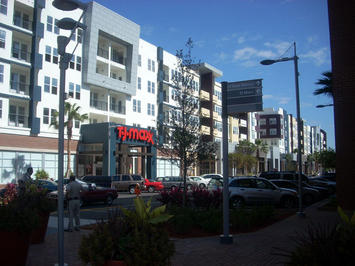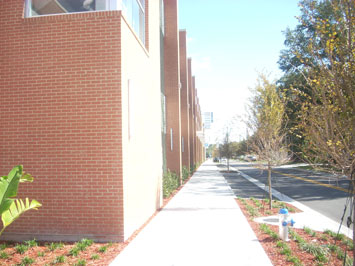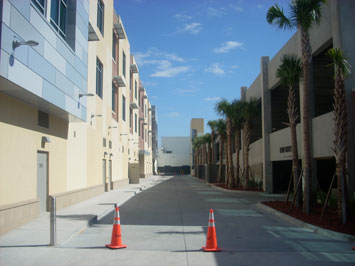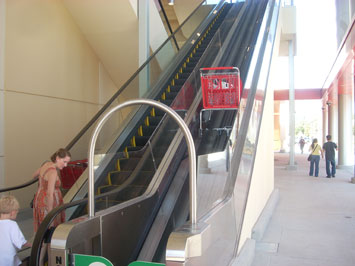
By Richard Reep
Urban infill in cities of the Southeast follows typical patterns: assemblage of several blocks of older building stock at a low price; careful navigation through the zoning and public process to mix uses and increase density; and finally design and construction of parking, office, residential, and retail uses. The next phase is often marked by alienation and departure of the existing surrounding residents, concerns of safety and security within the development, and a socioeconomic wall between new and old.
This sad pattern is evident in Orlando at Winter Park Village, a 90s New Urbanism infill, where a failed indoor shopping mall was eviscerated and converted to an outdoor retail and entertainment district. Initially it generated a buzz, attracted shoppers, and signed anchor tenants. But the adjacent lower-income residents benefitted not a whit from this development, surrounding land remains fallow or abandoned, and recent store closings call into question the long-term viability of the project.
Such problems worsened during the real-estate bubble, which promoted residential-driven development. This tore even bigger rifts in the fabric of cities. Sodo, the most recent cluster development opening in south Orlando at the dawn of financially uncertain times, could have a different future. This development is free from preconceptions about urban form and style and does not pretend the world is as simple as it was at the turn of the 20th century. Sodo offers a mix of uses clustered in medium density with access to jobs in the city’s older, denser infrastructure.
Typically, brave new residents buy into urban infill projects at a higher rate and higher price than the surrounding community, creating a class schism. The surrounding community in need of good jobs is reluctant to become the service workers in these developments, and this uneasy coexistence breeds anxiety and insulation. City planners consider these urban infills successful as they bring ‘higher-end’ residents (translated: higher tax contribution) and create the demand for more such projects. Older residents often despise the new construction and move out, driven out by a combination of increasing property values, loss of neighborhood identity, and a sense of alienation.
 In its infancy, Sodo appears to have the ingredients to become a good alternative to so-called “TND” or Traditional Neighborhood Development, as set forth by the Congress for the New Urbanism. Originally planned as condominium units, Sodo opens as a luxury rental community, which recognizes the current mortgage meltdown and the future of residential real estate in the Southeast. This neighborhood was typically oriented to the surrounding Wadeview railroad industrial district, but Sodo clearly looks north up Orange Avenue, beckoning hip, young, downtown workers.
In its infancy, Sodo appears to have the ingredients to become a good alternative to so-called “TND” or Traditional Neighborhood Development, as set forth by the Congress for the New Urbanism. Originally planned as condominium units, Sodo opens as a luxury rental community, which recognizes the current mortgage meltdown and the future of residential real estate in the Southeast. This neighborhood was typically oriented to the surrounding Wadeview railroad industrial district, but Sodo clearly looks north up Orange Avenue, beckoning hip, young, downtown workers.
With a certain gritty charm, South Orange Avenue winds below downtown, anchored by orange-bricked Orlando Regional Medical Center, a vast complex shoehorned into the old, industrial neighborhood. Sodo is not within walking distance of 300 luxury units worth of anything, not now nor in the near future, which makes it decidedly un-New Urbanist. But as the economy idles, Sodo has attracted some interesting comments from its neighbors that tell a positive story.
The development’s website is refreshing for what it does not proclaim in its marketing hype. It does not reference New Urbanist ideology anywhere. It does not claim to be a live-work-play solution to all life’s problems. It does not show happy white families riding bikes in parks. Its logo and presentation is simple and direct: Orlando is growing fast, and we want a piece of that pie. Rather than promote ideology, Sodo appears to promote itself as a blank slate upon which the future residents, retail and office tenants may write the future identity of this cluster.
It is probably dangerous to draw conclusions from blogs, because the bloggers do not represent a broad cross-section of the population. Computer-savvy, opinionated, and sophisticated, bloggers do not include many elderly, minorities, and people too busy with their lives to dash off a few lines about their feelings. Therefore, the local bloggers’ positive attitude about Sodo may not represent the entire range of feelings of people affected by this development.
However, rather than fear and loathing, Sodo has generated this: “I have had drunken people from the local bar (closing soon...HOORAY) pass out on my front yard. I am thrilled that this development is happening. It will no doubt enhance my quality of life and take us into a direction that the Wadeview Park area has sorely needed.” Similar comments abound, and the overall sense of approval from residents who bother to write about Sodo is a sign that this urban infill development is being welcomed rather than shunned.
Another sign that Sodo may blend into its neighborhood is the developer’s choice to market it as exclusively rental. Although the rental is “luxury” starting at $1,000 per month for 659 square feet, the economic step between this property and the next-door homes is less than it would have been if these units had been sold as 300 trendy urban condos.
 Examined closer, Sodo makes some concessions to reality. It connects to the surrounding street grid on 3 sides, and the sense of safety and security within Sodo is beefed up with private security. The apartments have uninspiring views into their own parking garages, and the lack of green space throughout is harsh and startling. In order to accommodate parking, the anchor retail store parks its cars on the roof; shoppers are treated to the novelty of an outdoor shopping cart escalator, which should be interesting during the monsoon season of Orlando’s summer.
Examined closer, Sodo makes some concessions to reality. It connects to the surrounding street grid on 3 sides, and the sense of safety and security within Sodo is beefed up with private security. The apartments have uninspiring views into their own parking garages, and the lack of green space throughout is harsh and startling. In order to accommodate parking, the anchor retail store parks its cars on the roof; shoppers are treated to the novelty of an outdoor shopping cart escalator, which should be interesting during the monsoon season of Orlando’s summer.
 While all this is encouraging, Sodo is not an example of organic growth, blending new and old seamlessly. For example, it is doubtful that Sodo residents and existing locals will bond over coffee in the Starbucks or burritos in the Taco Bell. Exclusively private, Sodo has no library, park, school, or other public amenity except for its shopping sidewalks, and it seems strange to think of Sodo hipsters venturing into the local community to worship, walk the streets, or volunteer. Sodo seems to be a social oasis, at least for the present moment.
While all this is encouraging, Sodo is not an example of organic growth, blending new and old seamlessly. For example, it is doubtful that Sodo residents and existing locals will bond over coffee in the Starbucks or burritos in the Taco Bell. Exclusively private, Sodo has no library, park, school, or other public amenity except for its shopping sidewalks, and it seems strange to think of Sodo hipsters venturing into the local community to worship, walk the streets, or volunteer. Sodo seems to be a social oasis, at least for the present moment.
Sodo therefore exemplifies the problems of growth with which Orlando grapples: if taken in lumps, like Sodo, growth represents a jarring socioeconomic schism between the old and the new. If taken in lower density, like subdivisions, growth represents huge tracts of land being gobbled up, a jarring ecological schism between the natural and the manmade. Less lumpy than most, Sodo seems to have timing in its favor, with the slower growth of the near future allowing it to enter the economic slipstream at a lower speed.
What is refreshing about Sodo, besides its crisp, clean, architecture, is that it does not carry the baggage of ideology and fetish for form that recent urban infill developments seem to carry. It is therefore free to evolve its identity by delivering safety and security to its residents, a sustainable mix of shopping and office spaces, and a sense of place that transcends the physical. Success is measured by functional yardsticks – not form yardsticks – and urban infill projects across the country can be measured the same way. Sodo may represent a realistic model of urban infill, welcomed by the community, able to assert its identity through the social and economic futures of its businesses and residents. This is the way healthy cities grow.
Richard Reep is an Architect and artist living in Winter Park, Florida. His practice has centered around hospitality-driven mixed use, and has contributed in various capacities to urban mixed-use projects, both nationally and internationally, for the last 25 years.












